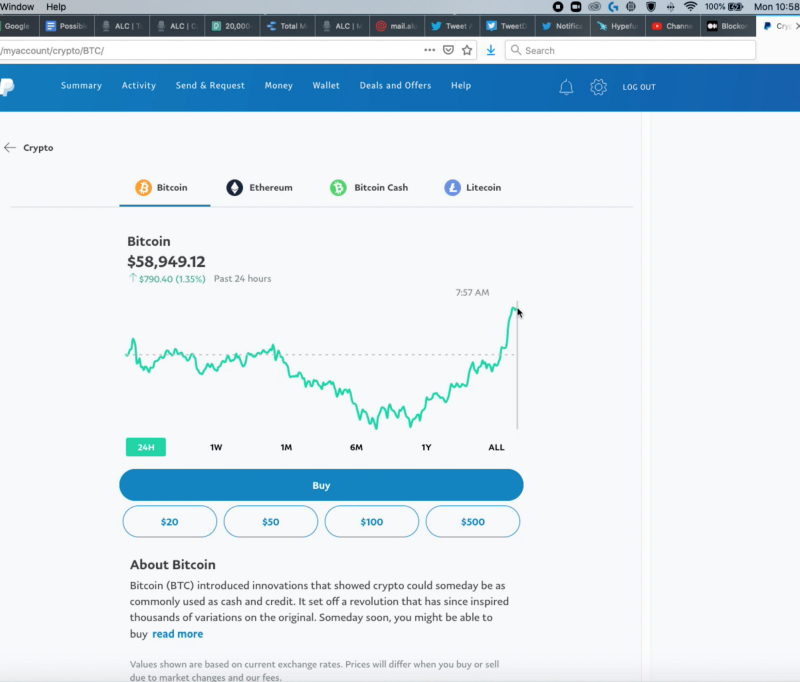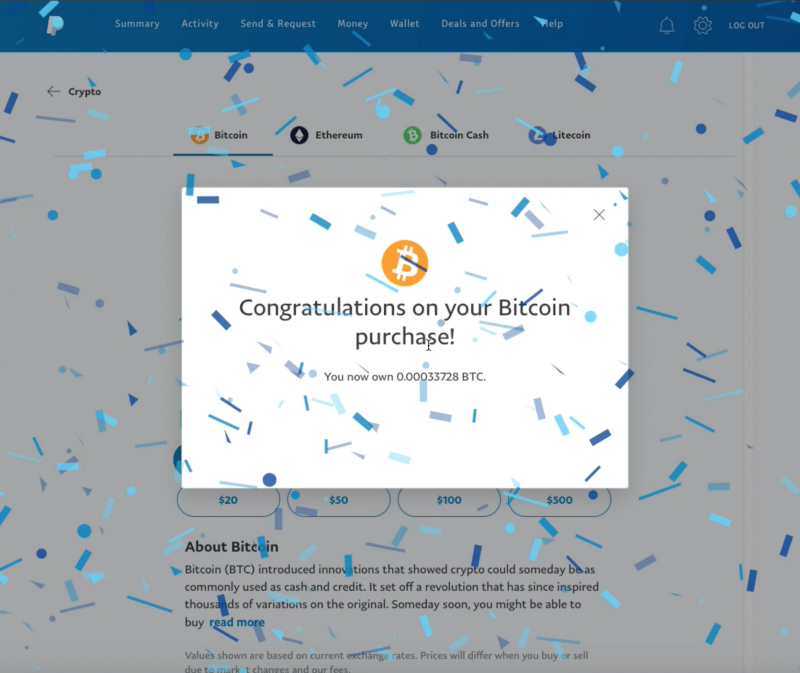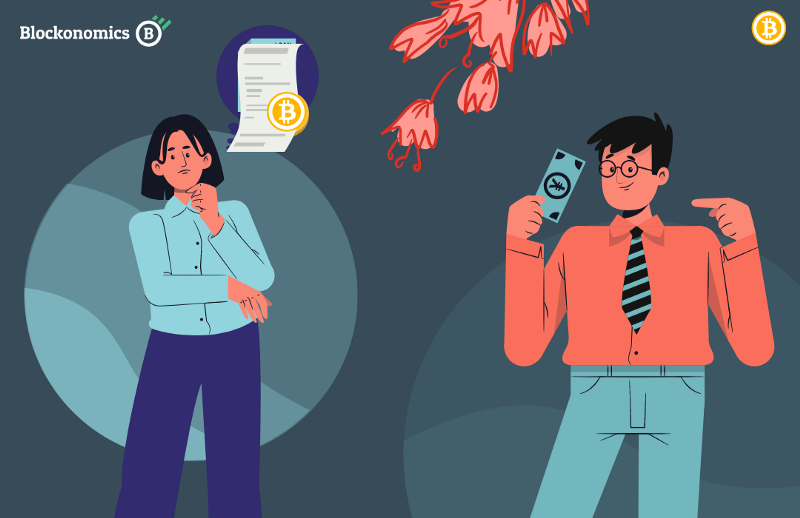The Truth About PayPal’s Bitcoin “Adoption”
PayPal has made a huge splash in Bitcoin news, first with their announcement of allowing users to purchase 4 cryptocurrencies, and then of…

PayPal has made a huge splash in Bitcoin news, first with their announcement of allowing users to purchase 4 cryptocurrencies, and then of allowing 26 million merchants to accept crypto including bitcoin. But how does this work in practice? Is PayPal’s system really worth all the hype? I’ve gone through the entire process from A to Z of PayPal’s cryptocurrency system so that you don’t have to.
I’m going to break this down into 3 parts: The Consumer Bitcoin Buying Experience, The Consumer Selling/Paying Experience, and The Merchant Experience. There are several caveats to keep in mind throughout this process.
- You do not have a private key for your wallet.
- PayPal does not let you move your Bitcoin off of PayPal.
- PayPal does not let you pay using Bitcoin from outside wallets.
- No Bitcoin is ever transferred on the Bitcoin Blockchain during entire the payment process.
It is worth looking closer into the fact 3 that PayPal does not let you pay using Bitcoin from outside wallets
.
PayPal’s system is a PR stunt from the start.
To try out PayPal I used my personal account. I am based in the US, only Americans can use the service. All of the research I performed below was performed by me, and the screenshots were ones I grabbed from an recording I performed while doing these transactions.
The Consumer Bitcoin Buying Experience
In order to purchase Bitcoin you have to start with KYC. This is fairly standard, most exchanges require KYC to follow legal standards. PayPal specifically required either a driver’s license or a utility bill. Slight problem because I don’t drive and utilities are included in my rent. I first tried to use my passport — no dice. But they didn’t send me any notification that I had failed, I had to constantly check to see if it was accepted. My second try I used my rental agreement, that was accepted. But again I received no notification.
After I was accepted, it was time to purchase the Bitcoin. I decided to only purchase $20 worth of Bitcoin. When going into the Bitcoin Buy screen, I was greeted with a pretty standard price chart. What I quickly noticed though, was they only showed the price from three hours ago. Notice in the picture below, it showed the price at 7:57am, but it was 10:58am when I was browsing.
I selected $20 and clicked on buy. I selected my payment method, and it was only then I saw a current exchange rate, and how much Bitcoin I was actually buying. I pulled up Kraken to compare. PayPal had a .50% markup, they quoted 1 bitcoin=$59,297, while Kraken quoted 1 Bitcoin=$58,978. There was a 50 cent fee.

This means that PayPal is making a profit on the transaction not through transaction fees but through markups. If someone purchased 1 Bitcoin when I purchased, for example, PayPal would make a $310 profit thanks to the markup.
The transaction was instantaneous, and PayPal congratulated me on purchasing Bitcoin.

Viewing your Bitcoin
To view your Bitcoin after purchase, PayPal will constantly show you USD amount, not the amount of Bitcoin you own. You have to move through several screens to see the amount in Bitcoin.
The price PayPal shows is the average of the Buy and Sell price. Because PayPal has a markup, this can bring down the worth of your Bitcoin quite a bit. For example right after purchase my $20 worth of Bitcoin was only $19.95.

Selling and Using your Bitcoin for Purchases
I am combing these two sections together, for good reason: PayPal doesn’t actually move any Bitcoin. When you purchase something with Bitcoin through PayPal you are selling your Bitcoin. That’s it.
Before you get started, PayPal needs more info from you. You have to provide your name and Social Security number. This is for tax purposes, they will also send you a 1099.
Starting with the sale of Bitcoin. The process is essentially the same as buying. When I looked into the process of selling, the markup was again high, .65%, with Paypal quoting $60,009 versus Kraken at $60,400. If someone sold a Bitcoin, PayPal would have received a profit of $391 on top of the 1.8% transaction fee.
Using Bitcoin for purchases is more interesting. All US stores that have PayPal should accept Bitcoin. You need enough Bitcoin before purchasing for the option to show. I searched several big name stores, like WalMart and Home Depot but none had the option. I’m assuming it was because the cart was too close to $20 for PayPal’s comfort. Finally I was able to get it to show with a cheap Etsy purchase.
On the payment screen there was Bitcoin below my normal PayPal payment options. Upon selecting the option, you are given a warning screen that detailed three items:
- You sell the Bitcoin to Pay.
- Refunds are given in USD.
- Sales are taxable.
Upon confirming those items, it shows you how much Bitcoin is being sold off, and the conversion rate. It quoted me $60,150 versus $60,508 on Kraken, that’s a .6% markup, with PayPal getting a $358 profit if someone purchased an item worth 1 Bitcoin. The price will fluctuate in real time. In the brief 2min I had it open, the price fluctuated rapidly. When first opened it was 60,150, with Kraken showing 60,508. After 1min the price started fluctuating reaching as low as 60,114 in 2 min, before going back up to 60,145. There was no visible timer for how long the price is locked in.

Using Bitcoin for payment doesn’t come with a transaction fee though, interestingly enough. That means you can technically bypass the sale transaction fee. When “Sell Bitcoin to Continue” is clicked, the sale of the Bitcoin is processed but not the purchasing of the product. I was able to sell off that $4 without a transaction fee. This is an interesting workaround if users are looking to save a few bucks.
The Merchant Experience
The Merchant experience is non-existent. PayPal’s Bitcoin payment processor is entirely a consumer side product. The merchant doesn’t have to do anything to accept Bitcoin. There are no extra fees. But on the flip side, they never see the Bitcoin. There is no option to keep any Bitcoin that is being used to pay for their products. All they see is the fiat currency.
PayPal’s new Bitcoin payment processor is fake, purely a PR stunt by PayPal. Why? Bitcoin is not changing hands. No Bitcoin is moving on the Blockchain. Users are essentially using PayPal Cash disguised as a cryptocurrency. The fact of the matter is, you are not using Bitcoin on PayPal. It is all smoke and mirrors.


![Top 10 Tools and Resources for Crypto Research [2021]](/content/images/size/w720/max/800/1-kDyyUnRCD656bm2ny-jHag.png)

Comments ()